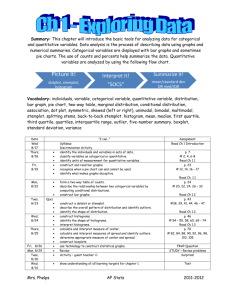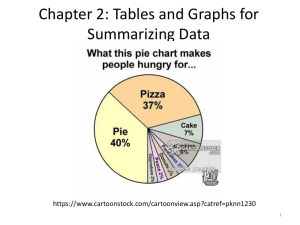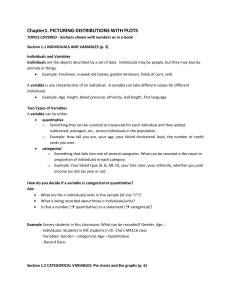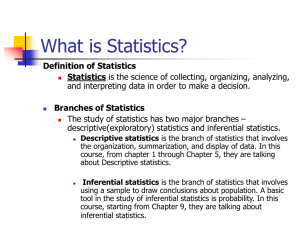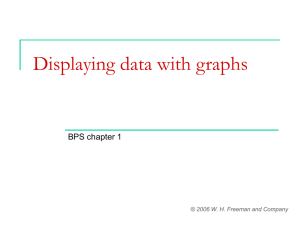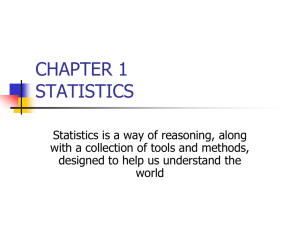Flipped W1F
advertisement
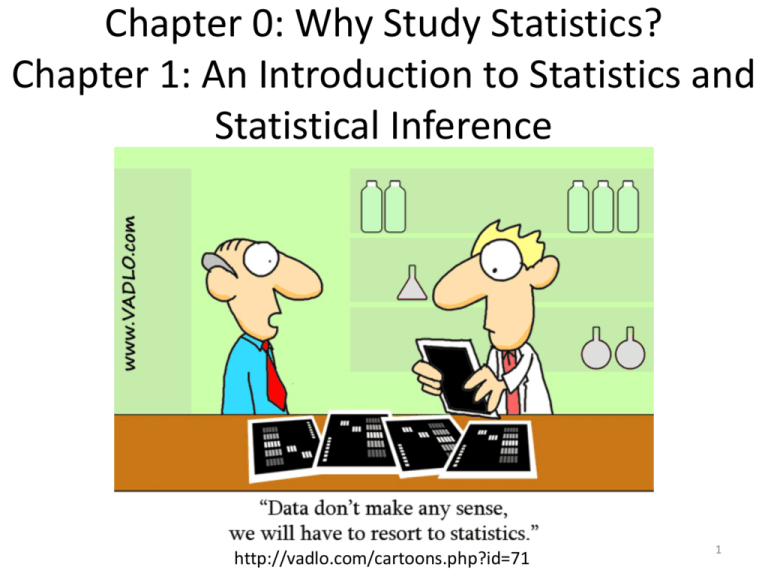
Chapter 0: Why Study Statistics? Chapter 1: An Introduction to Statistics and Statistical Inference http://vadlo.com/cartoons.php?id=71 1 0,1: Introduction: Goals • Create your own definition of statistics. • State some applications of Statistics for your field. • State the branches of statistics and briefly describe each one. • Define: Population, sample, variable • Differentiate between probability and statistics. • Be able to solve word problems in statistics. 2 What is Statistics • Components – Collection – Organization – Analysis – Interpretation 3 Branches of Statistics • Collection of data • Descriptive Statistics – Graphical and numerical methods used to describe, organize, and summarize data. • Inferential Statistics – Techniques and methods used to analyze a small, specific set of data in order to draw a conclusion about a large, more general collection of data. 4 Inferential Statistics • Claim – Status Quo • Experiment – Check claim • Likelihood – How likely is the experimental result consistent with the claim? • Conclusion – The outcome is reasonable – The outcome is rare. 5 Definitions • A population is the entire collection of individuals or objects to be considered or studied. • A sample is a subset of the entire population, a small selection of individuals or objects taken from the entire collection. 6 Probability vs. Statistics 7 Solution Trail 1. 2. 3. 4. 5. Find the keywords. Correctly translate these words in statistics. Determine the applicable concepts. Develop a vision, or strategy, for the solution. Solve the problem. 8 Chapter 2: Tables and Graphs for Summarizing Data https://www.cartoonstock.com/cartoonview.asp?catref=pknn1230 9 Types of Data, Graphing: Goals • Section 2.1 Classify variables as – Number of characteristics – Categorical or numerical • Section 2.2 (very brief) Analyze the distribution of categorical variable: – Bar Graphs – Pie Charts • Section 2.3: Skip • Section 2.4 Analyze the distribution of quantitative variable: – Histogram – Identify the shape, center, and spread – Identify and describe any outliers 10 Types of Variables • Number – univariate – bivariate – multivariate • Type – Categorical – Numerical 11 To better understand a data set, ask: • Who? •What cases do the data describe? •How many cases? • What? •How many variables? •What is the exact definition of each variable? •What is the unit of measurement for each variable? • Why? •What is the purpose of the data? •What questions are being asked? •Are the variables suitable? 12 Graphs • Categorical Variables – Pie charts – Bar graphs • Quantitative Variables – Histograms 13 Examining Distributions In any graph of data, look for the overall pattern and for striking deviations from that pattern. • You can describe the overall pattern by its shape, center, and spread. • For the shape, look at the number of peaks and the symmetry. • An important kind of deviation is an outlier, an individual that falls outside the overall pattern. 14 Frequency Distribution The possible values and how often that it takes these values. • The label or class is the category of the data. • The frequency is the count. frequency • Relative Frequency= total count 15 Categorical Variables - Display The distribution of a categorical variable lists the categories and gives the count or percent or frequency of individuals who fall into each category. • Pie charts show the distribution of a categorical variable as a “pie” whose slices are sized by the counts or percents for the categories. • Bar graphs represent categories as bars whose heights show the category counts or percents. 16 Quantitative Variable: Histograms Histograms show the distribution of a quantitative variable by using bars. Remember to always include the summary table. Procedure – discrete (small number of values) 1. Calculate the frequency distribution and/or relative frequency of each x value. 2. Mark the possible x values on the x-axis. 3. Above each value, draw a rectangle whose height is the frequency (or relative frequency) of that value. 17 Shapes of Histograms - Number Symmetric unimodal bimodal multimodal http://www.particleandfibretoxicology.com/content/6/1/6/figure/F1?highres=y 18 Shapes of Histograms (cont) Symmetric Positively skewed Negatively skewed 19 Shapes of Histograms (cont) Normal distribution Heavy Tails Light Tails 20 Outliers http://ewencp.org/blog/url-reshorteners/ 21
